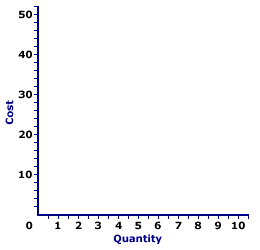
|
|
KALDOR-HICKS IMPROVEMENT: Based on the Kaldor-Hicks efficiency criterion, the notion that an action improves efficiency if the willingness to pay of those benefiting exceed the willingness to accept of those harmed. In other words, if those gains exceed those losses, or the benefits exceed the costs, then social welfare is improved and undertaking the action provides a net benefit to society. In other words, the winners can, in principle, compensate the losers for their loss, and still come out ahead. The actual compensation, however, is required. A contrasting condition for attaining efficiency is the Pareto improvement.
Visit the GLOSS*arama
|
|


|

|
                           TOTAL COST CURVES: The total cost of producing a good can be represented by three related curves, total cost curve, total variable cost curve, and total fixed cost curve. The total cost curve is the vertical summation of the total variable cost curve and the total fixed cost curve. | Total Cost Curves |  |
The three curves reflecting that total cost that is related to the short-run production are the total fixed cost curve, the total variable cost curve, and the total cost curve. The exhibit to the right can be used to display the three total cost curves.- Total Fixed Cost Curve: The total fixed cost (TFC) curve is a horizontal line. Click the [TFC] button to display the curve for Wacky Willy Stuffed Amigos production. Total fixed cost is equal to $3 and does not change with the quantity of output produced, thus the TFC curve is a flat, horizontal line.
- Total Variable Cost Curve: The total variable cost (TVC) curve is a positively-sloped line that reflects increasing then decreasing marginal returns. Click the [TVC] button to add this curve. The TVC curve emerges from the origin with a relatively steep slope, flattens, then becomes increasingly steeper. In the context of Wacky Willy Stuffed Amigos, the TVC for one Stuffed Amigo is $5, this then rises to $8 for two Stuffed Amigos, $10 for three Stuffed Amigos, etc., finally reaching $43 for ten Stuffed Amigos.
- Total Cost Curve: The total cost (TC) curve can be derived as the vertical summation of the TVC and TFC curves. In other words, the TC curve can be found by shifting the TVC vertically by the amount of TFC. This means that the shape of the TC curve is identical to that of the TVC. The two curves have identical slopes for each quantity of output. For Wacky Willy Stuffed Amigos production, the vertical difference between the TC and TVC curves is exactly $3.00, the value of TFC. Click the [TC] button to identify this curve.
An important conclusion from this derivation of the TC curve is that the vertical distance between TC and TVC curves is the same at ALL output quantities. The reason, of course, is that this vertical distance IS total fixed cost. Because total fixed cost is constant, the vertical distance is constant.From a geometric perspective, a constant gap between two lines means that the lines are parallel. While parallel lines are commonly presented as straight lines, two curved lines like the TC and TVC can also be parallel so long as they do not intersect and their distance remains constant. This further implies that the slopes of the TC and TVC curves are identical at each and every output quantity. In fact, it is acceptable to think of the TC curve as the result of vertically shifting the TVC upward by the amount of total fixed cost. In other words, the TC and TVC curves are essentially the same curve, the TC curve just happens to be a little bit higher in the diagram, higher by the amount of total fixed cost. However, in that the slope of the TC curve is marginal cost, the slope of the TVC curve is also marginal cost. Marginal cost, the increment of total cost resulting from a change in quantity, can be derived using either total cost or total variable cost. This point should be evident by noting that any quantity-induced change in total cost must come from total variable cost. Total fixed cost is fixed, it does not change. As such, marginal cost, the change in total cost, is not affected by total fixed cost.

Recommended Citation:TOTAL COST CURVES, AmosWEB Encyclonomic WEB*pedia, http://www.AmosWEB.com, AmosWEB LLC, 2000-2025. [Accessed: June 30, 2025].
Check Out These Related Terms... | | | | | | |
Or For A Little Background... | | | | | | |
And For Further Study... | | | | | | | | | | | | | |
Search Again?
Back to the WEB*pedia
|



|

|
PURPLE SMARPHIN
[What's This?]
Today, you are likely to spend a great deal of time searching for rummage sales seeking to buy either a birthday greeting card for your mother that doesn't look like a greeting card or a handcrafted spice rack. Be on the lookout for vindictive digital clocks with revenge on their minds.
Your Complete Scope
This isn't me! What am I?
|

|
|
Much of the $15 million used by the United States to finance the Louisiana Purchase from France was borrowed from European banks.
|

|
|
"I learned about the strength you can get from a close family life. I learned to keep going, even in bad times. I learned not to despair, even when my world was falling apart. I learned that there are no free lunches. And I learned the value of hard work. " -- Lee Iacocca
|

|
APT
Arbitrage Pricing Theory
|

|
|
Tell us what you think about AmosWEB. Like what you see? Have suggestions for improvements? Let us know. Click the User Feedback link.
User Feedback
|


|


